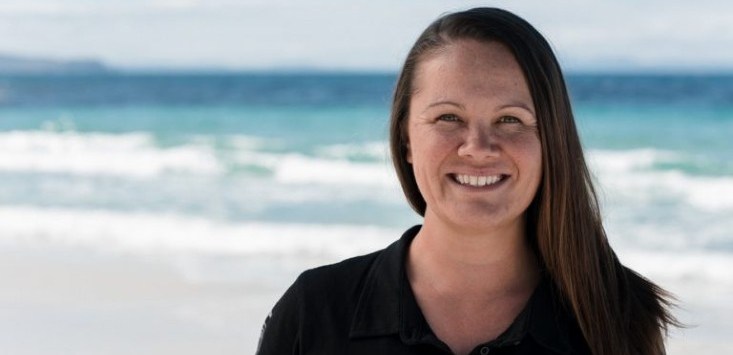
Mikaela Jade, founder and chief of Indigital. Source: Women's Agenda.
Mikaela Jade, founder and chief of tech company Indigital, has her best thoughts in the shower.
It’s where, nearly ten years ago, the idea to use augmented reality to tell Indigenous stories, popped into her head. She was working as a park ranger at the time, and knew there had to be better way to share traditional, Indigenous perspectives at cultural sites.
“My heart just broke every time we put a metal, aluminium sign in the ground in front of these cultural places that are so significant to the community that live there, and whose country it was,” Jade tells Shirley Chowdhary in the latest episode of The Leadership Lessons.
“But also, to all the visitors that were coming. The signs would say things like: “This is an Aboriginal site” and that would be it … not incorporating the traditional perspectives of the site at all.”
In 2012, Jade, a proud Cabrogal woman, had the opportunity to see augmented reality for the first time at a university event, and it’s spurred her on to create to use the cutting-edge technology.
“I went home and had a shower and this idea just popped into my head,” she said.
“What if we could use this technology where instead of reading a sign when you go to a place, couldn’t you just put your phone up and an elder could appear in holographic format and tell you the right story, for the right reasons, in the right language, at the right place, at the right time?”
Based in Kakadu at the time, Jade tells Shirley that everyone thought she was mad to pursue what then seemed to be such an outland-ish idea.
“Everyone thought I was mad,” she says, laughing. “I had no idea was I was doing! No idea what I was doing from a tech perspective — like, I’ve seen the tech, so I know that it exists. I just did a tremendous amount of stalking on LinkedIn and Google to work out ‘how do you do this?’”
Mikaela cold called lots of augmented reality pioneers around the world, before getting in touch with one, Jason Higgins in the UK, who said he would teach her about the technology.
“Even though I had this tiny amount of money, he could see the vision that I had and he spent two years teaching me online how to do augmented reality production,” she said. “He’s the best human.”
Mikaela also worked with traditional owners in Kakadu, sharing with them what this technology could do. She says they had their own ideas about what they wanted to do with it.
“This is why I love working with our mobs and new technologies because we don’t have the education system built in to our brains to help us think a certain way about technology. That’s why the work we do is really exciting.”
Indigital is now a company of eight people, made up mostly of an Aboriginal and Torres Strait Islander team, with Jade at the helm.
“We work from home, remotely, from our country. We’re also questioning what does it take to run a business and what does a business look like?” Jade says.
Jade explains that she’s faced multiple challenges when it comes to getting investment for Indigital, especially in the early days. Being an Indigenous woman who worked primarily from a remote area, seemed to always put her in the high-risk and too hard basket.
“There’s a lot of, to be honest, crap out there about Indigenous people and our ability to manage money, so we have to work harder to prove that we actually can manage money and we’re really good at,” she said.
“I actually had to build my company while I was full-time as a park ranger, just so I could pay the company’s bills out of my salary. It was really difficult.”
As an Indigenous woman leading a cutting-edge tech company, Jade believes she’s always going to face a degree of bias. As do other Indigenous women in STEM, who, in a Western sense, remain severely underrepresented. But as Jade explains, she believes the majority of Indigenous women are already scientists.
“We already have the world’s oldest living cultures, we already have knowledge systems about environment, about ecosystems, about systems, which is basically what technology is — but it’s not recognised through a qualification,” she says.
“We actually have tons of female Indigenous scientists and engineers and technologists and mathematicians. They’re just not getting a university degree.
“Does that make it any less relevant?”
This article was first published by Women’s Agenda.
Handpicked for you

AR presentation startup JigSpace bags $6 million for global growth



COMMENTS
SmartCompany is committed to hosting lively discussions. Help us keep the conversation useful, interesting and welcoming. We aim to publish comments quickly in the interest of promoting robust conversation, but we’re a small team and we deploy filters to protect against legal risk. Occasionally your comment may be held up while it is being reviewed, but we’re working as fast as we can to keep the conversation rolling.
The SmartCompany comment section is members-only content. Please subscribe to leave a comment.
The SmartCompany comment section is members-only content. Please login to leave a comment.